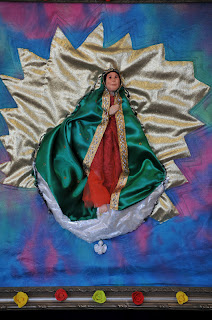The really great thing about working in a place like
Western Avenue Studios in
Lowell, MA, is that it is a huge community of artists, spread over five floors of an old mill in a run-down industrial area. The rent was really cheap, and the space was just bare bones. Since artists generally don't make a lot of money, it was an ideal spot to build the foundation for what the politicians like to call the
creative economy, a concept made popular among urban planners by a professor at the University of Toronto, Richard Florida. Lowell has long been known as a depressed, mill town dependent on one failing industry or another, not a reputation that will attract the best and the brightest to live there.
However, in the 1990's, the city looked at its resources and at other cities, most notably Boston, and saw that the price of real estate was climbing fast everywhere else, and that many of Boston's artists were being displaced by their own successes in building a vibrant creative community. Basically, artists move into a place that seems pretty hopeless, usually industrial spaces, and transform these places into somewhere the young, hip and moneyed want to be. This is great for a city. When people with money, free time and no kids move into a city, they want to go places, do things and spend their money. The places they go begin to attract small businesses that cater to these people. The small businesses grow and the city thrives. The revitalized city develops a reputation for being cool, hip and the place to be, which attracts real estate development, and more money. In fact, everyone benefits except the artists who created the success. Their rents go up and they lose their creative spaces. They are forced out and begin to look for somewhere new.
People in Lowell saw this happening in Boston and wisely offered their city up as a place artists could go, where rents were cheap and mills were empty. The city approached developers interested in re-purposing old mill space for artists, and offered them lots of money, tax breaks and encouragement to make new spaces for artists in Lowell. The earliest result was the
Ayer Lofts in the downtown, which was made into condos and an art gallery. The Ayer Lofts had previously been a downtown eyesore which had been an EPA
brownfields site (environmentally blighted). It was transformed into a beautiful, functional place that attracted new residents to Lowell who were interested in improving life in the city and had the wherewithal to do it. By all measures, the Ayer Lofts project was a success for Lowell. New museums, like the
Revolving Museum, opened in Lowell. New businesses like
Friends Fabric Arts, the
Mambo Grill, and
Brew'd Awakenings followed. Downtown began its rejuvenation.
All this was added to Lowell's reputation as the site of the largest, free folk festival in America:
The Lowell Folk Festival.
Lowell's reputation as a hip and happening place for the arts was on the rise. Once the
Arts League of Lowell was established, resident artists had a collective voice. The city government expanded its outreach through the
Lowell Office of Cultural Affairs. This later became known as the
Office of Cultural Affairs & Special Events (CASE). Lowell was now able to show that it cared about art and artists, and that it was willing to facilitate development based on cultural affairs. Thus, the seed was planted for the development of a dilapidated mill complex in the worst neighborhood in the city. This would become Western Avenue Studios, a showplace for all the best contemporary art that the city of Lowell has to offer.
Our little fiber arts studio, the Lowell Fiber Studio, was among the very first in the complex, located on the fifth floor, number 512. There were originally eight of us working there, Maxine Farkas, who had been our teacher at Friends Fabric Arts, Gay Tracy, Gwen Stith, Linda Branch Dunn, Margot Stage, Karen Bettencourt, Laura Gawlinski and me. Little did we know at the time that we would soon be joined by over three hundred other artists in the mill complex and be a featured studio in Quilting Arts Magazine (Issue 39, August/September 2009).
Western Avenue Studios was a great place to work. Walking down the halls and visiting friends' studios was always inspirational and fun. There is a real creative energy in the place, especially on the first Saturday of each month during Open Studios. Watch the video for a taste of Open Studios at Western Avenue!











